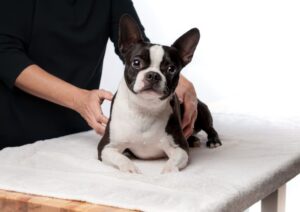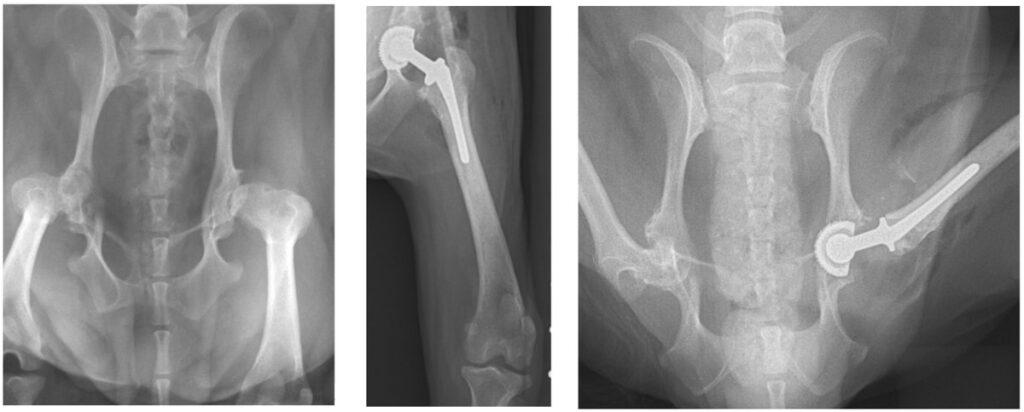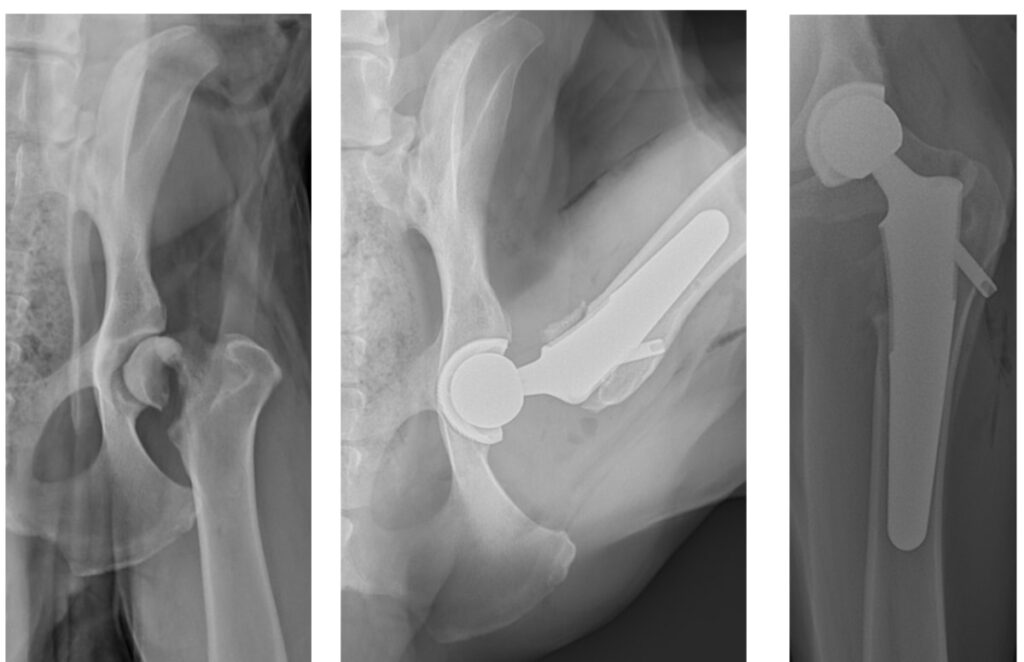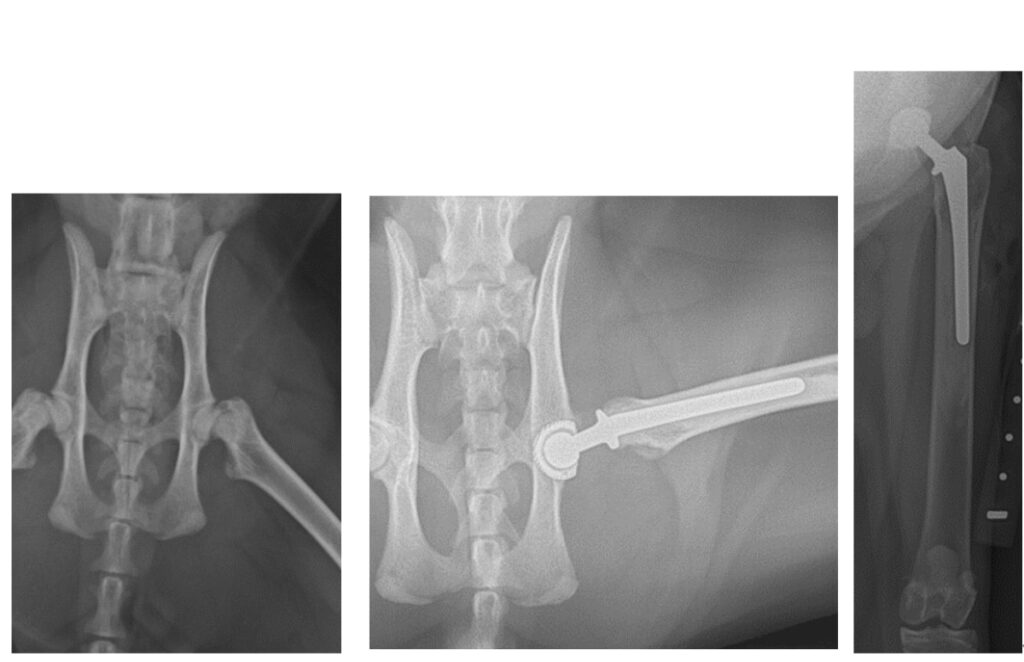

Pet 101
WHAT TO EXPECT IF MY ANIMAL IS REFERRED FOR A TOTAL HIP REPLACEMENT ASSESSMENT?
Total hip replacement (THR) is reserved for dysplastic animals with discomfort that conservative management could not fully alleviate. Total hip replacement is a salvage procedure, i.e., it is performed as a last resort where other treatments have proven ineffective.
Dogs with advanced osteoarthritis or dysplasia of the hip joint will, in some cases, benefit from the replacement of the hip joint. Total hip replacement is an advanced surgical procedure and should only be performed by experienced orthopedic surgeons.
Yet, THR remained the most effective surgical treatment for hip dysplasia in dogs. The surgeon replaces the entire joint with implants made of alloy (titanium/niobium/Cobalt/Chrome) and ceramic, thermoplastic (PEEK) or polyethylene (Cross link-UHMWPE). This is surgery that will provide better results than TPO. When executed well, it allows full functional recovery and eliminates osteoarthritic pains associated with arthritic changes in a dysplastic hip. The prosthesis should last the whole functional life of the dog.
Careful rehabilitation after total hip replacement is paramount. Post-operative patients should be managed diligently for the first 6 weeks after surgery. Physiotherapy could start after the ten post-op days. In most cases, leash walking is recommended for the first 12 weeks after surgery.
Currently, there are many THR systems; BioMedtrix, Kyon, Vetmaster, Bluesao, Innovet, Helica, Dingo, and in some specialized centers, they custom-make components for each case.
We use the BioMedtrix system for total hip replacements, as it is the most extensively documented system, with strong literature supporting its effectiveness and safety. Our surgeon has also developed extensive experience and expertise with this system, ensuring the highest level of care for our patients
CONSULTATION
Your animal is usually evaluated before surgery. It is not uncommon to have an animal presented with hip osteoarthritis and a concomitant pathology such as lumbosacral disease, stifle/knee disease, polyarthritis etc…We also want to make sure that based on history and orthopaedic examination, other alternative treatments may not be more appropriate (Cf the document When should I consider total hip replacement for my arthritic dog or cat).
After discussing the risks and benefits of total hip replacement, should you elect total hip replacement treatment for your animal, a CT scan or radiographs are taken for surgical planning and to ensure optimal implant size selection. The surgery is usually booked for a few weeks later, if not urgent.
PRE-SURGICAL ASSESSMENT
Dogs undergoing Total Hip Replacement are admitted early in the morning on the day of surgery. They must be starved overnight. They can have their last meal in the evening before surgery, but no breakfast on the day of surgery. They can drink overnight.
Before surgery, your animal will be assessed for any signs of skin or ear infection. Clipping the hair a few hours before surgery increases the risk of post-operative infection. To decrease that risk, your animal is only clipped after being anaesthetised. It means the signs of skin infection are sometimes identified after your dog has been anaesthetised. Should there be any sign of infection, the procedure must be postponed until these have resolved (via shampoo and antibiotics) to reduce the risk of hip implant infections.
WHAT IS THE SURGERY?
The procedure involves replacing the ‘ball and socket’ components of the hip joint with an artificial cup and ball. We use the BioMedtrix hip replacement system which consists of modular cemented and cementless system. This system is probably the most commonly used by veterinary orthopaedic specialists, and one of the most reliable systems on the market with results well documented in the literature. Furthermore, surgeons using that system must have an accreditation to ensure they have the qualifications to perform the surgery.
Two types of implants and fixation can be used, with or without bone cement. Cementless hip implants are ‘press fit’ and bone grows into pores in the implant surface. It has the advantage of long-term stability once the bone has fully grown into the implant. The cemented implants are fixed with bone cement. They are usually more stable in the early weeks, but they may be associated with a low risk of long-term aseptic loosening.
The decision to use a cemented or cementless system is quite complex and based on the individual patient.
ANAESTHESIA
Anaesthesia is performed by a Specialist to ensure the safest and best analgesia protocols are used.
HOSPITALISATION
Depending on their recovery and level of discomfort most of the animals will stay with us for one or 2 days. They usually use their leg the day following the surgery.
POST-OPERATIVE RECOVERY
Your dog should be walked on a short lead for a maximum of five minutes, three to four times daily for toileting only, then returned to the cage or pen. Your dog should be kept separate from any bouncy dogs while healing occurs. Patients should be walked slowly and encouraged to use the operated leg. Your dog must not be allowed to run around the house or in a park, play, jump onto or off furniture, climb stairs or fall on slippery floors for ten to twelve weeks.
Alternatively, animals not tolerating any pen or crate should be kept attached to a lead and stay on a non-slippery floor.
An abdominal sling should be used for the first two weeks to reduce the risk of slipping. It should be used for the first six weeks if walking on slippery floors.
Your dog’s use of the operated limb should consistently improve over the weeks following surgery.
Wound care: Skin incision should be checked twice daily for two weeks following surgery. Licking or chewing of the surgical site will cause infection and possibly dramatic complications. We recommend that a buster collar is worn (or any alternative device preventing leaking) until the skin sutures are removed. If discharge or increased swelling is noted you should contact us and an examination may be necessary.
Feline should be kept in a large pen or crate
Physiotherapy at home can be very positive but is not essential. It depends on how your animal can be handled
After 6 weeks: Radiographs or CT scan are repeated to ensure the hip is still in appropriate position and there is no sign of loosening. If all looks normal, the level of activity of your animal is increased gradually to allow the bone, muscles and tendons a gradual increase in load.
For a dog: following the 6-week recheck, your dog should still be walked on a lead, but the duration of the walk can be increased to 10 minutes 3-4 times per day for a week, 15 minutes 3-4 times a day the following week etc…until being able to walk about 30 minutes (5 weeks after the recheck). During that period your animal should still be rested at home and not allowed to jump and run.
For a cat: following the 6-week recheck, your animal can be free in a room for 2 weeks, but without furniture to jump on. Two weeks after recheck, they can be allowed access to a room with low-height furniture (chairs, sofa). Four weeks after the recheck, they are allowed full access to the house/apartment. Outdoor cats cat return to normal life 5 weeks after the recheck
WHY IS IT IMPORTANT TO REST MY ANIMAL?
Aftercare following THR surgery is critical for a successful outcome. Your pet will be discharged with painkillers and antibiotics. Most animals begin to use their operated limb on the day following surgery and are walking well within a couple of weeks. The joint capsule and muscle tendons which have been cut during surgery, will regain strength as they heal, this takes six to 12 weeks. During this time minor trauma (such as falling over) may result in tearing or stretching, and dislocation of the joint, which will require further surgery. A good result from hip replacement surgery depends on preventing accidents and inappropriate activity.
MY ANIMAL IS YOUNG AND BOUNCY, HOW CAN I MANAGE THE POST-OPRATIVE PERIOD?
A majority of dogs and cats suffering from hip disease are presented at a young age. They are usually very active. Usually, we prescribe sedatives be given during the recovery period. It can be on specific occasions or permanently. The objective is not to make your animal sleepy it is only to have them settled. We still want your animal to be happy to see you, the dogs wagging their tail, with good appetite. Sedation helps prevent young animals from being over-excited or distressed by the period of rest.
COMPLICATIONS
Major complication: Based on the literature, between 5 to 10% of patients experience short-term complications that require further surgery(ies). Analysis of pre-operative imaging can help further define the complexity of the procedure and the associated risks.
The most common complication is a luxation/dislocation of the hip joint. Multiple causes could explain that complication (wrong movement post-operatively, muscle tension that could decrease over the weeks following surgery, particularity of dog/cat anatomy, subsidence/implant moving inside the bone etc…). It can usually be addressed with revision surgery and a change of implant orientation, size or length.
Less common major complications that require further surgery (the list is non-exhaustive) are a fracture of the bone (often associated with excessive post-operative activity), dislocation of the patella (excessive muscle tension) or infection.
Minor complications: Potential complications include seroma (wound swelling) or wound infection, ongoing lameness, and sciatic neuropraxia (weakness of the operated leg due to irritation of the sciatic nerve) that are most of the time transient.
Eventually,95% to 98% of all patients who receive total hip replacement, recover full mobility..
WHAT HAPPEN IF THE COMPLICATION CAN NOT BE FIXED
Most of the time, when the complication cannot be fixed (in 2 to 5% of the animals), the worst scenario is we need to remove the implant from the bones. After implant extraction, your animal will have the equivalent of a femoral head and neck excision procedure. The clinical result of femoral head and neck excision is obviously not as good as a total hip replacement, however, usually your animal is still better than before the initial surgery.
MY ANIMAL HAS FULLY RECOVERED, WHAT IS THE NEXT STEP?
Animal activity: once fully recovered, after 10 -11 weeks, your animal can resume normal activity. They can run on the beach, take the stairs or jump on their favourite seat should they be allowed. Bear in mind that similarly to human total hip replacement, if your animal recovered a normal hip range of motion there are still some limits to it if they do a split or place their joint at an angle out of the “normal” range of motion.
Animal weight: It is still important to understand that although the implants are designed to stay for the life of your animal, they are still associated with a recommended weight limit. It means if your animal put too much weight after the surgery it may increase the risk of long-term implant breakage.
Illnesses: Remember to take your dog to your veterinary surgeon promptly if you notice any signs of infection e.g. skin sores, diarrhoea, urinary problems, cough, ear problems, or gum disease. Those bacteria could remotely go into the blood and contaminate the implant. The risk is extremely low, but if the hip replacement becomes infected, it will almost certainly not be possible to eliminate the infection without removing the prosthetic joint. If dental work is performed or your animal is neutered your dog should be pre-treated with antibiotics.
In summary, total hip replacement is a procedure that requires some commitment during the recovery period. However, it is worth it as it is the only one that will restore near-full hip function without pain or the need for mid to long-term medication.
A total hip replacement has been performed on a miniature dog weighing 2.3kg and suffering from hip dysplasia. A nano hip implant has been used, the head measures 6mm in diameter, the cup 10mm and the length of the stem (implant in the femur) is about 3 cm. The cup (implant in the pelvis) is “press-fit” and does not require any cement to be stable. For nano and micro stems, cement is, at the moment, needed to maintain the implant into the femur.
Radiographs a 65kg large breed dog with a chronic hip fracture. Press-fit, cementless implants have been used for both the cup and the femoral components. Note that the femoral stem has a lateral bolt to improve its post-operative stability
An 18-month male castrated cat was presented with a bilateral slipped capital femoral fracture (fracture of the ball part of the femur). The first hip was operated on using an uncemented press-fit cup and a cemented micro stem implant. The surgery on the other affected hip was successfully performed 5 weeks later.
More Posts




What is Rehabilitation?
Physiotherapy/rehabilitation is commonplace to help people recover from injuries and surgeries.

PennHip
The program was established at the University of Pennsylvania School of veterinary Medicine by Dr. Gail Smith in 1993.

 3899 8999
3899 8999








